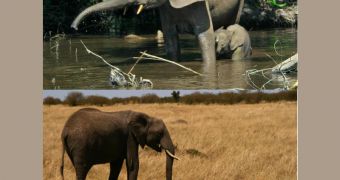Genetic analysis was used for the first time to prove that the African savannah elephant and the smaller African forest elephant belong to two different species, and have been separated for several million years.
The research involved scientists from Harvard Medical School, the University of Illinois, and the University of York in the United Kingdom.
Many scientists as well as many people believe that the African continent has only one species of elephants, even if there are significant differences in size between the savannah and the forest specimens.
The idea that the two could be separate species was first emitted in 2001, but there has been no scientific evidence so far.
To finally settle this matter once and for all, the researchers compared the DNA of modern elephants from Africa and Asia to DNA that they extracted from two extinct species: the woolly mammoth and the mastodon.
They were in for a surprise because, as David Reich, associate professor in the Department of Biology at York said, “forest and savanna elephants from Africa—which some have argued are the same species—are as distinct from each other as Asian elephants and mammoths.”
And even if scientists only had DNA from a single elephant in each species, they had collected enough data from each genome to go back millions of years of evolution to the time when elephants first separated from each other.
Professor Michi Hofreiter, who specializes in the study of ancient DNA in the Department of Biology at York said that “the divergence of the two species took place around the time of the divergence of the Asian elephant and woolly mammoths.
“The split between African savanna and forest elephants is almost as old as the split between humans and chimpanzees.
“This result amazed us all.”
The DNA analysis revealed a wide range of genetic differences between the species – the savanna elephant and woolly mammoth have very low genetic diversity, Asian elephants have medium diversity, and forest elephants have very high diversity, and researchers believe that this is because of the different levels of reproductive competition among males.
Another amazing thing is that, so far, many naturalists thought that African savanna elephants and African forest elephants were two populations of the same species, even if the size differences between them are more than obvious – the savanna elephant is 3.5 meters tall and the forest elephant has an average shoulder height of 2.5 meters.
Also, the savanna elephant weighs between 6 and 7 tons, whereas the forest elephant barely makes half of it.
Alfred Roca, assistant professor in the Department of Animal Sciences at the University of Illinois, said that starting now they “have to treat the forest and savanna elephants as two different units for conservation purposes.
“Since 1950, all African elephants have been conserved as one species.
“Now that we know the forest and savanna elephants are two very distinctive animals, the forest elephant should become a bigger priority for conservation purposes.”
This research is the first time that anyone has generated sequences for the mastodon nuclear genome, and also the first study that looks at the Asian elephant, African forest elephant, African savanna elephant, the woolly mammoth, and the American mastodon together.
Nadin Rohland, research scientists of the Department of Genetics at Harvard Medical School, added that “experimentally, we had a major challenge to extract DNA sequences from two fossils—mammoths and mastodons—and line them up with DNA from modern elephants over hundreds of sections of the genome.”
These findings appear online in PLoS Biology.

 14 DAY TRIAL //
14 DAY TRIAL //